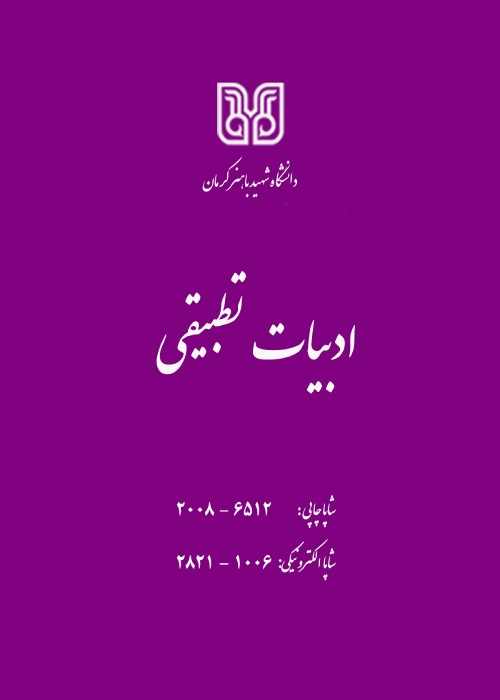Comparison of the meanings of the prepositions "B" in the Tarikh-i Bel'ami with the word "BA" in Arabic
Farsi speakers have not paid much attention to Persian grammar publishing for the last few centuries, particularly in the case of prepositions and their equivalent meaning in Jar letters. Researchers have encountered many difficulties, due to the significant role which these prepositions play in conveying meanings, especially in the translated texts of ancient Persian literature. Considering that Arabic is the language of the Qur'an and the religious language of Muslim Iranians, Many valuable books such as those pertaining to the literature and history are written in Arabic, so Persian speakers must be familiar with this language and its rules for translating literary and religious texts into Persian. One of these critical literary books is the Tarikh-i Bel'ami, translated from Arabic into Persian. An important feature of the book is its style of writing, which is very close to the Arabic prose, and too many Arabic vocabulary has been used throughout it. Notwithstanding the translator has tried to translate Arabic into Persian, following the Persian style, he was not successful on that. Because due to numbers of reasons, he created some meanings, which had never been applied in the second (destination) language before. Those reasons are introduced as follows. The role of the grammatical topic, the similarity of the meanings of the Persian prepositions with the Jar letters in Arabic, the influence of the book’s original language (Arabic) on the translated text, and considering the fact that the meanings of each language can affect on the second language through translation. In this book, many Persian prepositions are adapted from Arabic or vice versa. In this paper, the meanings of the Persian prepositions "BE" compared with the Jar letter "BĀ" in the Arabic, as well as comparing their similarities and differences. By doing this research, the equivalence of the "BE" and "BĀ" becomes more accurate through the translation of the bilingual texts, and the substitution of the words associated with those is going to accomplish more accurately. Eventually the possible translation errors are going to be reduced, and the exact meaning of each word extracted from source texts are going to transfer to the destination texts correctly.
This research is fundamental and is done based on the criticism and analysis of data and documentation. The method of data collection is library-based and then analyzed by the comparative method. For this purpose, firstly, the Persian and Arabic grammatical books about the prepositions "BE" and the Jar letter "BĀ" were studied. Then, the meanings of these two words were extracted using authentic books and references. It is important to note that in the course of this study, the book of Tarikh-i Bel'ami was thoroughly examined. The statistical population is the preposition, "BE," in the Tarikh-i Bel'ami and the Jar letter, "BĀ." The analysis of the data in this study is based on a comparison of written evidence and documents, and any specific tools for this research have not been used.
The Jar letters are BA, TA, CAF, LAM, WAV, MONZO, MOZ, kHALA, ROBBA, HASHA, MEN, ADA, FI, AN, ALA, HATA, ELA. (Ibn Malik, 1996: 34) These letters are one of the most essential categories of the Arabic language that link the meaning of the verb to the noun. Some have stated that since the ability of some verbs to reach out the object is too low, these letters help the verb to reach out the object. (Ibn Aqil, 2011:3/8) The primary meaning of the letter "BĀ" in Arabic is "Elsagh." This letter is one of the seventeen letters of Jar that comes up before the noun and makes it "Majror," and has all the properties of the Jar letters as well. (Ibn Hisham, 1999: 2/11) The common meanings of the letter "BĀ" in the Arabic language with the preposition "BE" in the Tarikh-i Bel'ami book include: "Elsagh", "Sababiat or Talil", "Mosabehat", "Ghasam", "Zarfiat-e Makani," Zarfiat-e Zamani, " Mojavezat (An / Az) "," ["BĀ" synonymous with "Men" and "BE" synonymous with "Az"], "Estela", "Esteanat", "Entaha-e ghaiat", "Avaz va Badal", "Movafeghat va Motabeghat". Uncommon meanings of the preposition "BE" with the letter "BĀ" in the Arabic language in the the Tarikh-i Bel'ami include: "Tozih", "Seirourat", "Esteghragh-e Jens va Bayan-e Vahdat", "Tavali va Ta’aghob", "Moshabehat", "Ra-e Mafouli", "Taghsim", "Haal", "Souy va Janeb", "synonym of Dar-bareye", "Ekhtesas", "Mozadat", "Moghayese va Nesbat", synonyms "Kasre-e Ezafe"," "synonym of Be-Rasme, Be-Onvane, and Be-Masabe", "synonym of Bar-Ohde-e, Bar-Zemme-e", "Meghdar va Andaze". The non-common meanings of the letter of "BĀ" in Arabic with the preposition, "BE," include: "Moghabeleh," "Tadieh", "Tafdieh," "Tabeiz", "Ba-e Takid".
There are many different meanings for the Arabic Jar letter, "BĀ", and the Persian preposition, "BĀ". The total number of the meanings of "BE" and "BĀ" is thirty-five, which thirty of them goes to "BE, and the rest eighteen goes to the "BĀ". These two letters share thirteen meanings; the preposition "BE" alone has seventeen meanings, while the letter of Jar "BĀ" has five of these meanings (Table 1). Therefore, in addition to considering the many commonalities in this field, we can say that the meaning of "BE" is more extensive than "BĀ," and the application of the most meanings of "BE" in the Tarikh-i Bel'ami is enormous (Fig. 1). We also state that the Persian language, especially the language of ancient texts, is highly influenced by Arabic rules and has plenty of grammatical commonalities, including; the common meanings in the Jar letter and preposition. In order to obtain these meanings, mastery of the Arabic language and the rules of that are necessary. Table 1: Number of Differences, common, and Total meaning of the preposition "BE" with Arabic Jar letter "BĀ"
- حق عضویت دریافتی صرف حمایت از نشریات عضو و نگهداری، تکمیل و توسعه مگیران میشود.
- پرداخت حق اشتراک و دانلود مقالات اجازه بازنشر آن در سایر رسانههای چاپی و دیجیتال را به کاربر نمیدهد.


